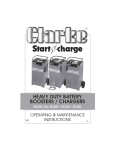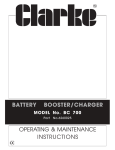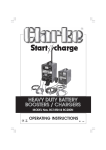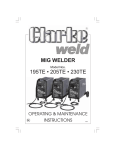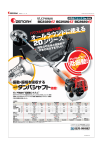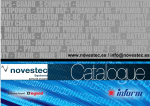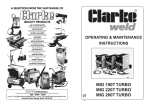Download Clarke BC335 Instruction manual
Transcript
HEAVY DUTY BATTERY BOOSTERS / CHARGERS MODEL Nos. BC260N & BC335 OPERATING & MAINTENANCE INSTRUCTIONS 0707 Thank you for purchasing this CLARKE Battery Charger. These units are suitable for charging and boosting 12 or 24 Volt lead acid batteries. Before attempting to operate the unit, please read this instruction manual thoroughly, and follow all directions carefully. By doing so you will ensure the safety of yourself, and others around you, and at the same time, you should look forward to the unit giving long and trouble free service. GUARANTEE This product is guaranteed against faults in manufacture for 12 months from date of purchase. Please keep your receipt as proof of purchase. This guarantee is invalid if the product has been found to have been abused in any way, or not used for the purpose for which it was intended, or to have been tampered with in any way. The reason for return must be clearly stated. This guarantee does not affect your statutory rights. CONTENTS PAGE Specifications ................................................................................................ 2 Safety Precautions ........................................................................................ 3 Electrical Connections ................................................................................. 4 Parts Identification ........................................................................................ 4 Procedure For Normal Charging ............................................................... 5 Procedure For Normal Charging with Timer ............................................. 5 Procedure For Engine Starting ..................................................................... 6 Parts Lists & Diagrams ................ BC260N ................................................... 7 - 8 BC335 ...................................................... 9 - 10 Wiring Diagrams ............................................................................................ 11 SPECIFICATIONS MODEL 260N 335 Supply Voltage 230 230 Max Charge (Amps) 40 50 (cont) Max Boost (Amps) Boost/Charge (Volts) Internal Fuse Rating Internal Fuse Part No. 250 300 12/24 12/24 200A 300A EM22220008 EM22220011 Part No. When disposing of this product, ensure it is disposed of according to all local ordinances at a proper disposal facility. DO NOT dispose of with general waste. 2 IMPORTANT: SAFETY PRECAUTIONS PLEASE READ BEFORE USING THIS UNIT 1. WARNING: Some electronic equipment can be damaged by boost charging or use of start facility. Check your vehicle handbook before using your Start ’N’ Charge. If in doubt consult the vehicle manufacturer. Nevertheless, you should not operate this equipment unless you are fully conversant with vehicle electrical systems, and battery charging techniques. 2. WARNING: Because highly inflammable hydrogen gas is released in the process of battery charging, please remember to switch OFF the charger first, and so avoid sparking which will occur when CONNECTING OR DISCONNECTING LIVE LEADS. 3. Black negative (-ve) lead must always be clipped to the negative, and Red positive (+ve) lead must always be clipped to the positive. When charging with battery installed in vehicle, or boosting, FIRST connect the appropriate lead to the UNEARTHED battery terminal (on most modern cars this is the positive (+ve) terminal), then connect the other lead to the chassis (or a suitable engine bolt) away from the battery and fuel line. It is advisable to disconnect the unearthed terminal from the battery, when charging in situ. When disconnecting, remove the chassis lead FIRST, then the battery lead. 4. To prevent battery overheating and consequent damage, use the BOOST facility sparingly and do not exceed our recommendations. 5. Battery acid is highly corrosive. If spillage occurs, wipe off immediately and wash copiously with water. Particularly avoid contact with the eyes, but if this occurs, you must seek medical advice. 6. When charging is completed, ensure that the vehicle battery leads are secured to the proper terminals which should be clean and lightly smeared with petroleum jelly to prevent corrosion. Finally, re-check the electrolyte level. 7. Do not expose this unit to rain. 8. Never touch together the negative and positive leads on this unit whilst the unit is switched on. 9. Never attempt any electrical or mechanical repair. If you have a problem with your machine contact your local dealer for service information. 10. WARNING: Certain types of sealed or maintenance-free batteries need extra care when charging. Please consult battery manufacturers instructions before using this unit. 11. WARNING: Since toxic fumes may be released during battery charging, ONLY USE THIS UNIT IN A WELL VENTILATED AREA. 12. Before charging ensure the battery terminals are clean and that the cells are filled with electrolyte to the correct level by adding distilled water where necessary. 3 ELECTRICAL CONNECTION Connect the three core mains lead to a suitable industrial supply isolator, or heavy duty plug. These chargers must be connected to a supply having a rated capacity of greater than 13 Amps. WARNING: A 13 Amp (BS1363) plug is not suitable. The maximum input amperages for these units are: BC260N - 40amps, BC335 - 36amps WARNING: THIS APPLIANCE MUST BE EARTHED IMPORTANT: The wires in the mains lead are coloured in accordance with the following code: Green & Yellow - Earth Blue - Neutral Brown - Live As the colours of the flexible cord of this appliance may not correspond with the coloured markings identifying terminals in your plug proceed as follows: • Connect GREEN & YELLOW coloured cord to plug terminal marked with a letter ‘E’ or Earth symbol ‘ ’ or coloured GREEN or GREEN & YELLOW. • Connect BROWN cord to terminal marked with a letter L or coloured RED • Connect BLUE cord to terminal marked with a letter N or coloured BLACK If in doubt, consult a qualified electrician. PARTS IDENTIFICATION Fig. 1 A - Timer Control Knob B - Current Control Knob C - 12 V Positive Terminal D - 24 V Positive Terminal E - Mains Indicator Lamp F - Thermal Overload Indicator G - Ammeter H - Fuse 4 PROCEDURE FOR NORMAL CHARGING NOTE: All references in brackets refer to Fig. 1 1) Before charging or boosting, ensure that the cells are filled with electrolyte to the correct level by adding distilled water where necessary. 2) Where appropriate we recommend that the non-earthed lead on the battery is disconnected prior to charging. It is possible that damage may occur to any electronically controlled system fitted to the vehicle such as engine management, anti-theft alarm, alternator etc. 3) Check that the mains supply is OFF and the Current Control Knob (B) is in the ‘O’ OFF position. 4) Connect the appropriate lead to the unearthed battery terminal (on most modern cars this is positive (+ve) terminal), then connect the other lead to the chassis (or a suitable engine bolt) away from the battery and fuel line. NOTE: Ensure the RED (+ve) lead is plugged into the 12V or 24V receptacle, depending upon the voltage of the battery to be charged 5) Remove the battery filler caps, where appropriate, during charging in order to prevent the build up of dangerous gases within the battery. 6) Switch ON the mains supply 7) Turn the Current Control Knob (B) to the position necessary to obtain the required charge rate, as indicated on the ammeter - 3 charging rates are provided. CAUTION: Avoid high charge rates with sealed batteries 8) Keep the battery on charge until the Ammeter (G) reads zero (or 0-2 amps) or has stopped moving down, then turn the Current Control Knob (B) to the OFF position. 10) When disconnecting the charger, disconnect 1. supply, 2. chassis conductor and 3. battery conductor, IN THAT ORDER. Important: If the fixed positive lead and the fixed negative lead are connected to the wrong terminals, then a flash will occur when the 2nd Clamp is attached. Damage to the charging unit and the battery will be avoided as your START’N CHARGE is fitted with a polarity protection feature. It will however be necessary to replace the internal fuse. Remove the black plastic cover on the front panel (marked ‘fuse’) and replace the burnt fuse with an exact replacement. See ‘Specifications’ for replacement fuses. CHARGING WITH TIMER 1. Follow the same instructions as for NORMAL CHARGING UP TO AND INCLUDING PARA. 6 2. Turn the timer control knob (A) clockwise to the desired charging time setting. 3. Switch ON the mains supply. 4. Turn the Current Control Knob (B) clockwise to position 5 or 6, to obtain the desired charging rate as indicated on the ammeter. 5 Notes on charging procedure. * A complete charge is best done slowly in order to protect your battery We recommend the charging ratebe no more than 10% of the battery capacity rating (AH). eg. a typical battery has a rating of 40 Ampere Hours, therefore the charging rate should be 4 amps , and a complete charge will take 10 hours. ** If a low current reading (2 amps or less) is seen on the gauge, this may indicate that the battery is either (a) already fully charged or (b) at the end of its useful life and in need of replacement. Do not charge the battery for longer than is necessary. Check the SG of the battery with a hydrometer PROCEDURE FOR ENGINE STARTING Note: We recommend that before attempting to boost start you charge the battery for 10-15 minutes. This will improve the chance of a first time start, particularly with big engines. When the battery is completely flat, you must charge the battery for 10-15 minutes before attempting to start, otherwise you may cause damage to the vehicle electronic systems. a) Check that mains supply switch is OFF and the Current Control Switch is in the OFF position. b) Connect the cables as for normal charging. c) Switch ON the mains supply. d) Turn the Current Control Knob (B) in the BOOST START position. e) Turn the vehicle’s ignition switch to ‘start’, then press the button on the Remote Control to provide a boost. IMPORTANT: If the engine fails to start after a MAXIMUM of 10 seconds, release the button on the remote control, and the ignition switch. You must then wait for at least 30 seconds before retrying. Failure to follow this procedure may cause damage to some electronic equipment on the vehicle and may also damage the battery and the Start ‘N’ Charge unit, which could invalidate your guarantee. f) When the engine has started, switch the Current Control knob (B) to the OFF position, then disconnect the charger. Disconnect 1. supply, 2. chassis conductor and 3. battery conductor, IN THAT ORDER. 6 PARTS DIAGRAM BC260N 7 PARTS LIST BC260N No. 01 Description Qty Part No. Switch Knob 0.34 1 EM21690015 02 Switch 12 A 1 EM22205133 03 Timer 16A 250V 1 EM22215001 04 Timer Knob 1 EM21690034 05 Upper Control Panel 1 EM33710273 06 Ammeter 50A/Start 1 EM22600027 07 Front Frame 1 EM21690322 08 Rectifier Pms 12/2/2 1 EM22400045 09 Complete Thermostat 1004 + Support 1 EM04600113 10 P.C.Board For Remote Control 1 EM22700001 11 PVC Input Cable 3x2,5 M.2,5 1 EM20220020 12 Transformer Starter 230V 1 EM44105046 13 Lower Panel 1 EM33700028 14 Remote Control Cable Without Plug 1 EM40210768 15 Black Cable 16 Sqmm Mt.2,5 W/Clamp120 1 EM43200016 16 Red Cable 16 Sqmm 1 EM04600067 17 Earth Clamp (pair) 120A 1 EM22110005 18 Wheels-Axle D.20 1 EM55200001 19 Wheel 0.175 Rubber Hole D.20 2 EM21625009 20 Fuse Box Cover 1 EM21690110 21 Fuse 200A 1 2EM2220008 22 Orange Pilot-lamp 220V 1 EM22610014 23 Green Pilot-lamp 220V 1 EM22610008 24 6 Lobe Hand-wheel D.40 2 EM21800042 25 Insulating French Washers 2 EM21615012 26 Cable Clamp For Hose D.10 Grey 2 EM21605034 27 Front Panel Aut.700 1 EM33700722 28 Cover Panel Aut.700 1 EM33705346 Handle Aut.700 1 EM33725080 29 8 PARTS DIAGRAM BC335 9 PARTS LIST - BC335 No. Description Qty 01 Switch Knob 1 EM21690015 02 Switch 12 A 1 EM22205133 03 Timer Knob 1 EM21690034 04 Timer 16a 250V 1 EM22215001 05 Upper Control Panel 1 EM33710285 06 Ammeter 50A 1 EM22600017 07 Front Frame 1 EM21690322 08 Rectifier Pms 20/2/2 1 EM22400011 09 Complete Thermostat + Support 1 EM04600113 10 P.C. Board 1 EM22700001 11 Input Cable 3x2.5 M2.5 1 EM20220020 12 Transformer 1 EM44105075 13 Thermostat Support 1 EM04600261 14 Contactor 220v I0A 1 EM22225006 15 Lower Panel 1 EM33700028 16 Remote Control Cable 1 EM40210768 17 Black Cable 16 Sqmm 1 EM43200016 18 Earth Cable 16 50mm 1 EM43200015 19 Dinse Plug 25sqmm 1 EM22100001 20 Clamps 120A 1 EM04600067 21 Wheels-axle 1 EM55200001 22 Wheel D.175 Rubber 2 EM21625009 23 Big Fuse Box Cover 1 EM21690110 24 Fuse 300A 1 EM22220011 25 Orange Pilot-lamp 220V 1 EM22610014 26 Green Pilot-lamp 220V 1 EM22610008 27 Female Dinse Plug 25sqmm 2 EM22100002 27 Cable Clamp + Screw 2 EM04600234 28 Cable Clamp 1 EM21605009 29 Front Panel 1 EM33700722 30 Panel 1 EM33705346 31 Handle 1 EM33725080 10 Part No. WIRING DIAGRAMS BC260N BC335 11











